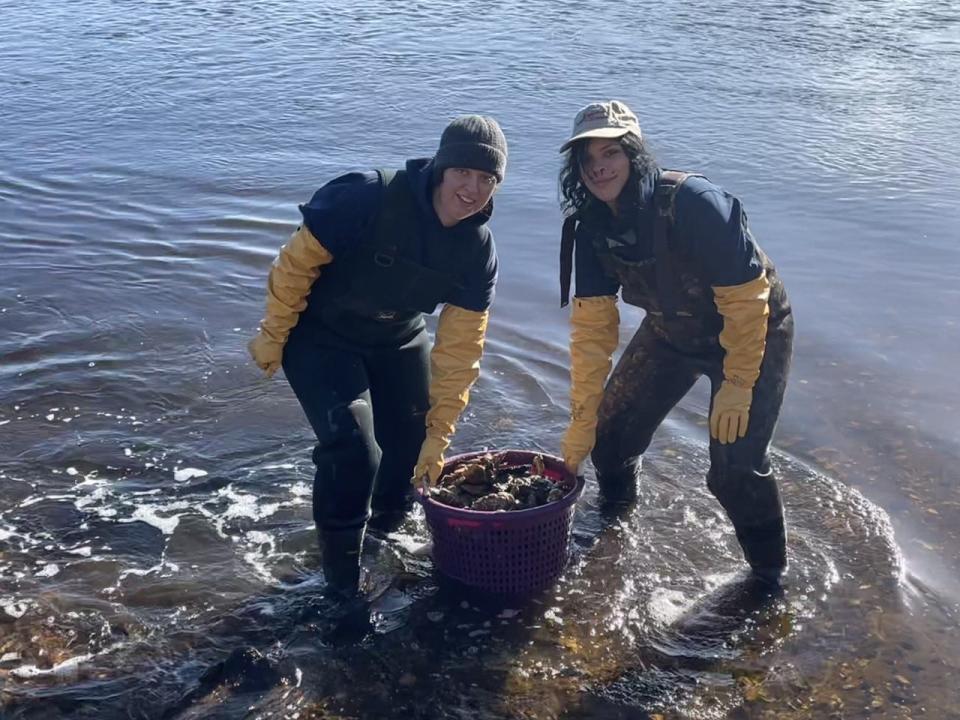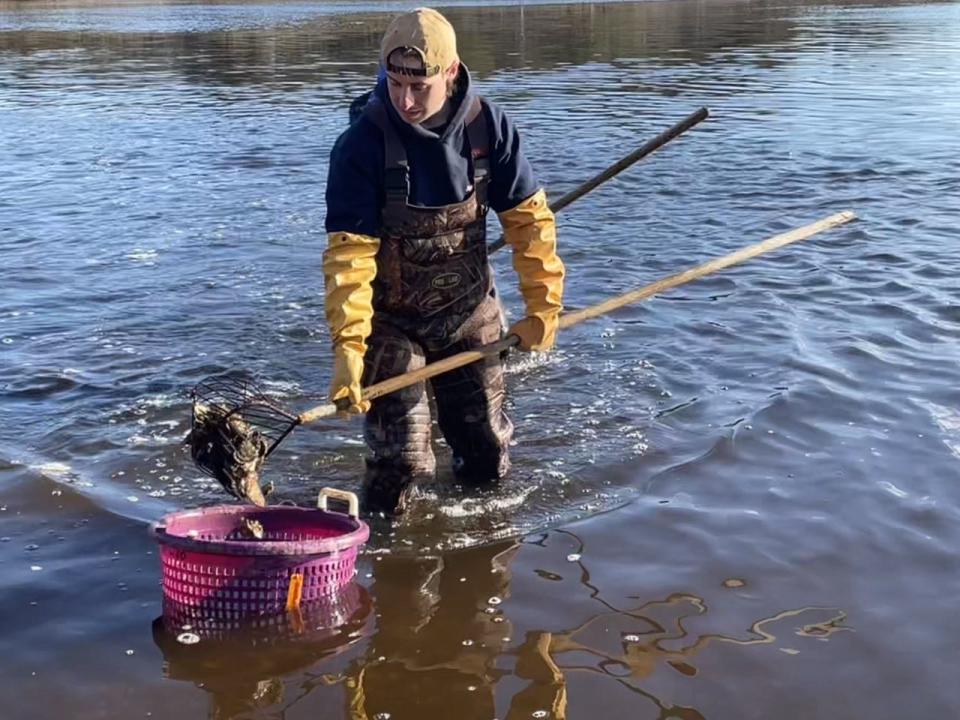Wild oysters rescued in Wellfleet ahead of Herring River dike work
WELLFLEET — At Saturday morning's low tide, as the waters at Chequessett Neck slowly peeled away, a dense bed of wild oysters began to appear along a flank of the dike, on the Herring River side.
Surveying the scene from a narrow path running parallel along the steep embankment, five AmeriCorps Cape Cod members, clad in waders and carrying oyster basket rakes, knew at a glance they had their work cut out for them.
Led by Wellfleet shellfish constable Nancy Civetta and assistant shellfish constable for propagation Johnny "Clam" Mankevetch, the group intended to relay the shellfish to another spot on the west side of the structure, closer to the harbor.

The oysters, with some quahogs scattered among them, were growing within the prohibited shellfishing zone — restricted to harvesting because of water quality — and were moved with permission from the Massachusetts Division of Marine Fisheries because of construction work getting underway to replace the dike as part of the Herring River Estuary Restoration Project.
In March After 20 years of planning, Wellfleet celebrates start of Herring River restoration project
"We are moving oysters that are in the way of being destroyed by construction," Civetta said. "It's going from one side of the prohibited area to the other side of the prohibited area. We're just trying to save oysters that could become spawning stock."
The last time the department undertook a relay like this was ahead of dredging in front of the harbormaster's office at the Wellfleet marina in 2021, Civetta said. It's work that's carefully undertaken in keeping with Massachusetts shellfish regulations.
Previously reported Wellfleet awards harbor dredge contract to Burnham Associates

Wellfleet shellfishing community said wild oysters were in danger.
Mankevetch said it was the first time he's been involved in a relay at the dike. Their ultimate destination was a spot where he thinks the oysters, which he described solely as "brood stock," will have the best chance of achieving spawning biomass.
Mankevetch noted that a local fisherman, Michael Parlante, who's been involved in preparatory work for the Herring River project, alerted the shellfish department to the presence of the wild oysters.
"The important thing is to listen to the shellfishing community and if they're concerned, then we are," Civetta said.
Helping with the relay were AmeriCorps members Will Longo of Bridgewater, Leonel Lainez of Brockton, Jodi Monroe of Fayetteville, North Carolina; Emma Grace Deily-Swearingen of Amesbury, and Avalon Hadley of Foxborough.
At first it looked as though the shellfish were just rocks, said one AmeriCorps worker.
As the members worked, sloshing through the murky brown water, the low-slung sun rays showed their figures in silhouette.
"At first I thought a lot of these were going to be rocks, but they're all shellfish," said Deily-Swearingen, almost incredulous, as she abandoned her rake and kneeled in the water to gather oysters by hand. She put them into a bucket.

In the months they've been working on various projects around the Cape, which started in the fall, Hadley said, "I feel like this is the most shellfish we've dealt with."
Nearby, Monroe also found it easier to gather the oysters by hand. She said the work was challenging, but satisfying.
"I like being outside and getting to do stuff with my hands," she said, as she brought up a handful of shellfish and tipped them into a basket floating at her side. "And I think this is a very important cause. They would die otherwise, so we are saving them."
How did the oysters get past the dike and end up upstream?
Mankevetch surmised the wild bed was seeded by larvae that made their way past the dike from the harbor. While the area on the river side of the dike is not ideal for the shellfish, since it is "well closed and acid," his impression was that the section along the edge where the group was working was "a little less acid," and just good enough for development of a bed.

That said, he noted, "there's some evidence they're a bit stressed," pointing out some of the oysters had holes in their shells. "Think of calcium-based shells in acidic water," he said. "It's like Alka-Seltzer."
Mankevetch and Civetta helped tote buckets and baskets laden with oysters to the top of the dike and dumped them into the back of two shellfish department pickup trucks. Civetta also ended up kneeling in the water to pluck oysters off algae-slick rocks along the shoreline.
Later, the oysters were transported to the marina and loaded by the bushel onto the department's boat, then taken to the area just east of the dike and deposited. It took two boat trips, and when all was said and done, Civetta said, "we did about 40 bushels."
With about 500 oysters to a bushel, the total number of oysters relayed was estimated to be about 20,000. But that's a conservative guess.
"Because there was also seed," said Civetta, "there could have been even more."
Heather McCarron writes about climate change, environment, energy, science and the natural world, in addition to news and features in Barnstable, Brewster and Falmouth Reach her at hmccarron@capecodonline.com, or follow her on Twitter @HMcCarron_CCT
Gain access to premium Cape Cod Times content by subscribing.
This article originally appeared on Cape Cod Times: Wild oysters moved in Wellfleet ahead of Chequessett Neck dike work

